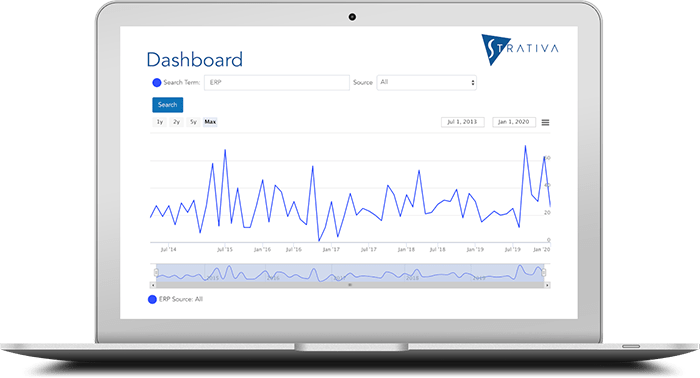
Salesforce.com is proving to be a popular platform for developing ERP systems, and its annual user conference, Dreamforce, has been a great way for us to catch up with all of them in one place.
Last year, we provided an update on the four ERP providers building on the Salesforce platform in a single post. This year we hope to cover them in separate posts, starting with this one, on Kenandy, then moving on to FinancialForce, Rootstock, AscentERP, and a new entrant this year: Sage Live.
Swimming Against the Tide
Unlike cloud-only ERP providers such as NetSuite and Plex, Kenandy is not interested in a “two-tier ERP strategy.” The strategy of “two-tier” refers to the targeting of small divisions or operating units of larger companies that are running Tier 1 solutions, typically SAP or Oracle, at headquarters and in larger divisions. The cloud provider then targets its ERP solution for smaller divisions of the company with integrated to the corporate system, usually for shared services such as financials, central order processing, or cross-company supply chain management. NetSuite points to customers such as Jollibee Foods and NBTY (China) Trading Company as multinational companies implementing NetSuite in a two-tier strategy. Similarly, Plex boasts of Caterpillar and Inteva Products as success stories in two-tier ERP.
Going against this trend, Kenandy executives say that, although they will not turn away two-tier opportunities, they would rather work in what they consider a more strategic role with customers. This means targeting (1) large enterprises for a complete ERP solution, or (2) serving as a more agile “orchestration” solution for new lines of business within large enterprises.
In the first category, Kenandy has one big customer where it provides the full and exclusive ERP solution. This is Big Heart Pet Brands, the former pet food division of Del Monte Foods. (Big Heart was recently acquired by J.M. Smucker Company). At over $2 billion in revenue, Big Heart is most likely the largest company running a cloud-only system as its only ERP system. We wrote more about Big Heart in our post last year.
In the second category, there is one large customer working to implement Kenandy as an orchestration solution for a line of business. This is Philips, where Kenandy is being rolled out as an order provisioning system for its HealthCare Informatics Solutions and Services (HISS) group. The new system will orchestrate fulfillment and provisioning processes that span multiple product categories, internal systems, and suppliers. Rod Butters, Kenandy’s President and COO, claims it was able to develop a proof of concept to demonstrate the feasibility of its approach in two months. That was enough to seal the deal, and the new system is scheduled to go live within the next year.
Kenandy shared with us other similar deals, but they are not ready to be referenced publicly. If Kenandy can continue closing these two types of large deals, it will break the mold of cloud ERP vendors primarily serving small companies or larger companies in only a two-tier configuration.
Serving as a Full ERP Solution to the Mid-Market
This is not to say that Kenandy is abandoning its mid-market customers. The firm continues to pursue small and midsize businesses, though it eventually hopes to leverage a partner channel to better serve this market.
We spoke to one such new customer, Mike Paler of CivicSolar. CivicSolar is a rapidly growing solar equipment distributor to commercial installers. The company is growing annually at a 50% pace and needed an integrated ERP solution to replace its custom-developed system. Mike was drawn to Kenandy in part because it covered all of the firm’s operational requirements without having to combine it with a separate financial system.
Unlike the majority of ERP systems sold on the Salesforce platform, CivicSolar was not a Salesforce customer prior to engaging with Kenandy. Nevertheless, as part of its Kenandy implementation, it plans to migrate from Zoho CRM to Salesforce.com’s Sales Cloud. The implementation is now underway with go-live scheduled for 2016.
Continuing to serve the SMB market will be an important part of Kenandy’s success. Smaller deals provide a more consistent pipeline and will be important for Kenandy to build out its functionality for a broad set of customers.
Expanding the Leadership Team
Just prior to Dreamforce, Kenandy announced the hiring of a new CEO, Charles Berger. Sandy Kurtzig, Kenandy’s founder, will move up to the Executive Chairman role.
Chuck comes with a long track record of leadership positions in the tech industry, most recently as CEO of Extreme Networks. In our interview with Chuck, we also learned that his experience includes sitting on the other side of the table, buying and implementing ERP.
Since we first interviewed Sandy after the unveiling of Kenandy at Dreamforce 2011, we felt that ultimately the firm would be well served by bringing in senior leadership beyond Sandy. This move to expand the executive ranks is a good sign for Kenandy’s future.
Refreshing the User Interface and Embedded Analytics
On the product side, Kenandy is in process of upgrading its user interface to take advantage of new Lightning capabilities of the Salesforce1 platform. Lightning is essentially new generation of Salesforce1, allowing a developer to more rapidly build an application user interface that can be deployed across multiple desktop and mobile devices. There are multiple components for things like search bars, charts, related lists and so forth, and developers can also build their own components specific to their applications that they build on the platform. Kenandy’s use of Lightning will allow it to keep pace with Salesforce.com and further increase its ability to roll out new system features.
In addition, Kenandy is working to embed analytics as a native part of the application. In our view, embedding business intelligence capabilities in the application means that the app itself can focus on the business process. Instead of writing reporting or look-up logic as part of each application, let the embedded analytics serve the information needs of the user in the middle of the process.
Other vendors, such as Workday, Infor, and Oracle are also moving in this direction. In the case of Kenandy, the embedded analytics are not yet part of the standard product but are under development. Kenandy is investigating the new Salesforce Wave Analytics for possible use in providing these embedded analytics.
In conjunction with its future analytics capabilities, Kenandy is also experimenting with the new Thunder real-time event processing engine announced by Salesforce to capture large volumes of data from connected devices, such as smart products, manufacturing machinery, or any number of sensor-based equipment.
Recommendations for Buyers
So, what customers are a good fit for Kenandy? The company has some good references in consumer-packaged goods (see Big Heart Pet Brands, mentioned earlier). It also has wins in electrical and electronics manufacturing, industrial products, and energy industry product and service providers, among others.
More broadly, Kenandy characterizes its ideal customer as one that combines and delivers a product with a service. Kenandy wants to work with customers at the leading edge of innovation. In the case of product manufacturers, these are largely those that have services offerings that complement their product portfolio. CivicSolar, mentioned earlier, is one example: the company not only distributes solar panels and other components, it also provides design services and other personal assistance to solar installers.
Still, no ERP system is a fit for every company. Kenandy is a relatively young ERP provider, although its choice of the Salesforce platform is allowing it to rapidly build out new functionality. Nevertheless, new prospects may find gaps between their business needs and what Kenandy can currently offer out of the box.
Interestingly, in our discussions with Kenandy customers, we find that some of them actually wanted this. Kenandy’s relative youth allows new customers to strongly influence its product roadmap and be a primary source of requirements. In other cases, in our ERP selection consulting work, we find that some buyers prefer a more complete solution out of the box.
Buyers considering Kenandy should decide into which category they fall.

